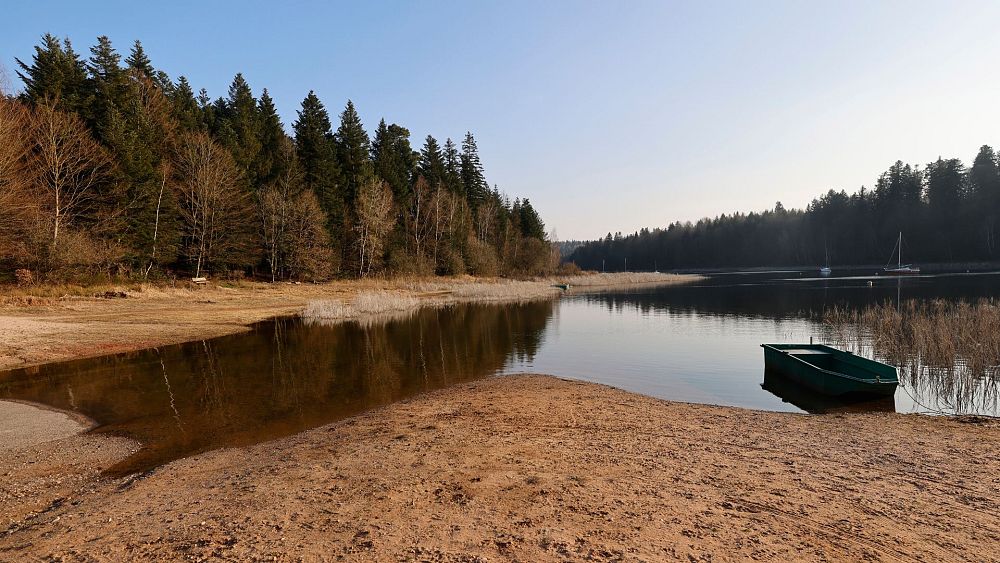Fears for food supplies as Italy and France brace for another drought

Italy and France are bracing for a second consecutive year of drought after an abnormally dry winter.
Across parts of western Europe, dried up riverbeds and shrunken lakes – usually only seen in the height of summer – are currently a common sight.
Governments are mapping out action plans to prepare for diminished crop yields – and to restrict water usage ahead of what will likely be another hot and dry summer.
How are different European countries saving water – and what will it mean for farmers?
Italian farmers might have to switch crops
Italian Prime Minister Giorgia Meloni has decided to appoint an “extraordinary commissioner with executive powers” to carry out the government’s drought battle plan. Italy appointed someone to a similar position to implement strategies against the COVID-19 pandemic.
Experts say the last time the nation experienced two back-to-back years of drought was 1989-90 but that conditions are more severe now.
With scant winter snowfall translating into vastly insufficient snowmelt to supply streams and tributaries that flow into Po River, farmers in Italy’s Emilia-Romagna region worry they might have to abandon traditional crops like corn and soy and plant sunflowers instead.
The region is one of Italy’s most productive agricultural areas. The lack of water could also affect the supply of animal feed for Emilia-Romagna’s cows and pigs, whose milk and meat are essential to producing Parmigiano Reggiano cheese and prized prosciutto.
Italy last year reeled under its worst drought in 70 years, and the Po, its longest river, turned into a long stretch of sand. The drought battered the rice plants that supply the main ingredient for risotto.
What precipitation Italy received late last month seemed to do more harm than good for some farmers. A combination of lower temperatures, snow and frost threatened fruit crops that, due to a warmer winter, had already started blooming, notably almond, peach and cherry trees, the agricultural farm lobby Coldiretti said this week.
“The arrival of precipitation in any case won’t succeed in making up for the water deficit in a situation in which Italy is 30 per cent short of water, with the percentage rising to 40 per cent in north Italy,” Coldiretti noted, citing data from Italy’s National Research Council.
While briefing lawmakers on Wednesday, Italy’s minister of agriculture and food sovereignty, Francesco Lollobrigida, described the lack of water as an emergency. He cited infrastructure as a contributor to the problem.
“We must intervene with planning for the long-, medium- and short-term period to make aqueducts, which have leakage as high as almost 50 per cent, more efficient and devise a plan for reservoirs and water basins,” Lollobrigida said.
France to step up ‘water sobriety plan’
France recorded 32 days without rain this winter – the longest winter drought since record-keeping began in 1959. Snow levels in the French Alps, the Pyrenees and other French mountain ranges are also much lower than usual for this time of year, the national weather service has warned.
Since snowmelt is crucial to filling rivers and reservoirs, weather-watchers are worried about depleted water supplies later this year.
Around France, residents are sharing images of dry riverbeds and lakes – shocking sights in the depths of winter.
French President Emmanuel Macron promised his government would devise an urgent “water plan” in mid-March.
The last two summers in France also were exceptionally dry, prompting some farmers to consider switching to new crops.
Earlier this week, France’s environment minister ordered officials who are working on what Macron’s government calls its “water sobriety plan” to take immediate steps to restrict water usage to ensure there is enough water this summer.
Four regions in southern France – Isere, Var, Bouches-du Rhone and the Pyrenees – already have water restrictions in place, and 10 other departments were placed on the vigilance list.
Other western European countries fear water shortages
Germany and Spain have recently experienced some rain. However, the situation is still worrying.
In Germany, experts say that rain around the start of the year will not be enough to replenish deeper parts of the soil that have become worryingly dry in recent years.
Germany’s Federal Statistical Office said this week that drought and heat led to a significant drop in the vegetable harvest last year, which was down 12 per cent compared with 2021 – a record year – and down two per cent compared with the five-year average.
Thanks to recent rain in Spain, water reserves are at 51 per cent capacity, way above the dangerously low 35 per cent of late 2022.
Last year was Spain’s third-driest year and the hottest one since 1961, when record-keeping started.
Dry conditions remain a worry in Spain’s Catalonia region, where water use has been restricted in agriculture and industry since November and using potable water to wash cars or fill swimming pools is prohibited.
Source: Euro News















